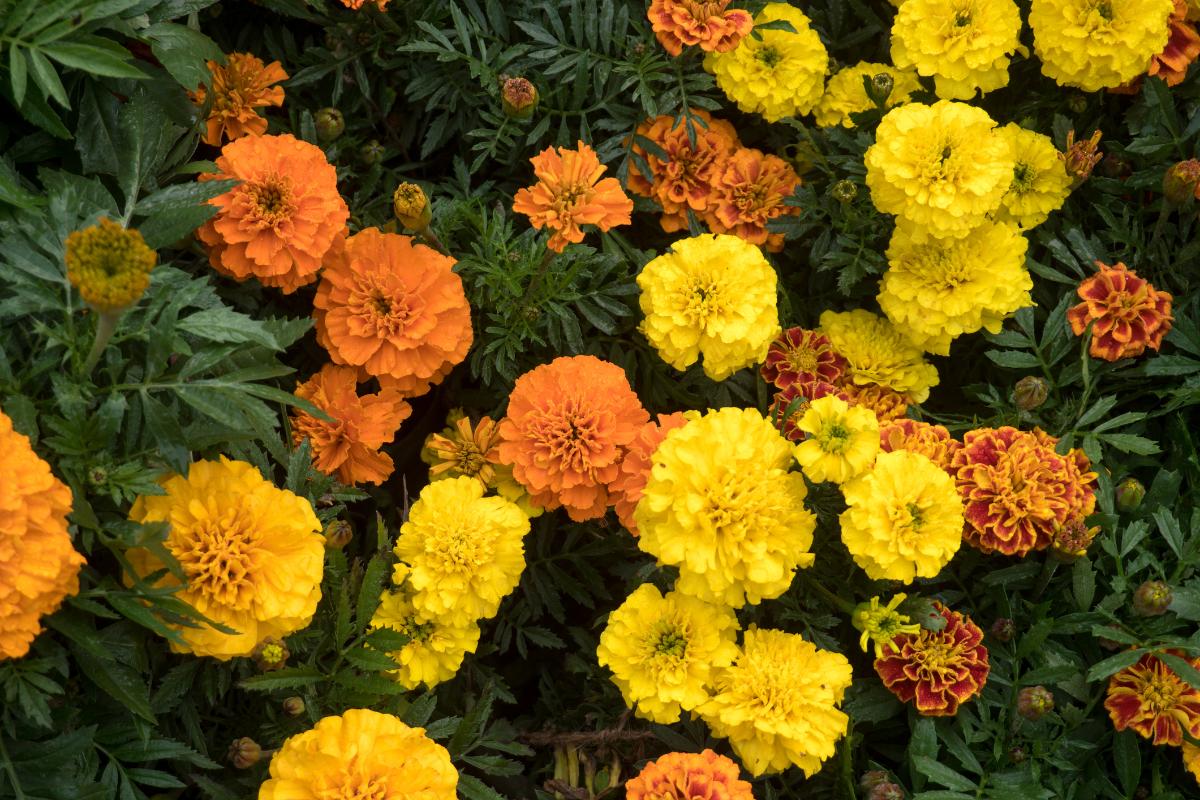Summertime can be rather stressful for many plants and flowers. The heat, humidity, and sunrays evaporating the water can make it almost impossible for plants to establish roots and grow healthy.
However, some flowers can handle this weather and even thrive in it, leaving you with amazing blooms come spring!
So, today, we’ll share with you seven flowers to plant in August and enjoy their bloom next season!
1 – Marigold
- Hardiness Zones: 2–11
- Soil Requirements: well-drained and loamy
- Sun Requirements: full sun daily
Gardeners love marigolds for their bright, cheerful blooms that light up gardens with hues ranging from sunny yellow to deep fiery oranges.
These flowers are typically round and full, with multiple layers of tightly packed petals that give them a lush pom-pom-like appearance.
Some varieties like the French marigolds, have smaller, more delicate flowers. Others, like the African marigolds, boast larger, ruffled blooms that can reach four inches in diameter.
2 – Hydrangea
- Hardiness Zones: 3–9
- Soil Requirements: moist and free-draining
- Sun Requirements: partial shade
If you want large, showy flower clusters, a hydrangea is the way to go! These blooms can range from vibrant blues to purples to soft pinks and whites, often changing hues based on the soil.
They’re often used as the focal point in garden designs, their grand dramatic flowers creating a sense of fullness and abundance.
Most gardeners plant hydrangeas in spring and fall. However, you can also plant them in the summer, but keep an eye on the flowers as they’ll need more watering.
3 – Pansies
- Hardiness Zones: 7–10
- Soil Requirements: fertile and well-draining
- Sun Requirements: full or partial sun
One of the best things about pansies is that each flower typically features a distinctive “face,” with a central blotch of a darker color, contrasting with the outer petal.
Pansies come in a wide variety of colors, including vibrant yellows, deep purples, bright blues, and rich reds, as well as soft pastels.
These flowers are relatively small compared to the previous ones, but they appear in abundance, creating a dense carpet of color when mass-planted.
4 – Calendula
- Hardiness Zones: 2b–11a
- Soil Requirements: well-drained and nutrient-rich
- Sun Requirements: full sun to partial shade
Commonly known as pot marigold, Calendula is a cheerful, easy-to-grow flower that can brighten your garden with warm, sunny blooms!
You can find them in vibrant shades of orange and yellow, resembling daisy-like blossoms with layers of delicately ruffled petals.
Apart from their aesthetic appeal, calendula flowers are edible and often used in salads or as a garnish, adding a pop of color to dishes!
5 – Asters
- Hardiness Zones: 3–8
- Soil Requirements: well-drained and loamy
- Sun Requirements: full sun
Another daisy-like flower that can cover your garden come spring is the aster.
They come in shades of purple, pink, blue, and white with the centers often a contrasting yellow, creating an eye-catching display.
Aster blooms are relatively small, typically about one to three inches in diameter, but grow in plenty, creating a dense blanket of color in garden beds and borders.
Moreover, asters aren’t only visually appealing but also highly attractive to pollinators, especially bees and butterflies!
6 – Salvia
- Hardiness Zones: 3–9
- Soil Requirements: well-drained and light
- Sun Requirements: full sun but some can bloom in partial shade
Salvia, also known as sage, is a striking plant that adds vertical contrast to your garden with vibrant colors.
The most popular garden varieties produce tall spikes with tubular flowers that come in bright reds, blues, pinks, and deep purples.
Salvia’s foliage varies depending on the species, but it’s typically aromatic and can be either smooth or slightly fuzzy.
Its drought tolerance and low-maintenance needs make it an excellent choice for new gardeners.
7 – Common Poppy
- Hardiness Zones: 1–10
- Soil Requirements: well-drained and moist
- Sun Requirements: full sun to partial shade
Famously known as Flanders or field poppy, the common poppy is renowned for its delicate, paper-like petals and vibrant blooms.
These iconic flowers have become a symbol of remembrance and are celebrated for their simple, yet striking beauty.
Each bloom features four to six silky petals that form a shallow cup, typically in brilliant red, although other colors such as pink, white, and orange can also be found in different varieties.
Final Thoughts
Now, have you decided what flowers to plant in August? There are many more than mentioned, but these seven are some of the best options to get started!
By choosing flowers that can handle the later summer heat, you’re setting your garden up for a burst of color and life in the coming seasons.
So, grab your gardening gloves and start planting!

Growing up with a mom who filled her home (inside and out) with all sorts of plants, Lisa got her start in gardening at a young age. Living now on her own with a home and yard full of plants (including an indoor greenhouse), she shares all the gardening tips she’s gained over the years.

